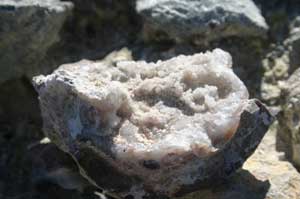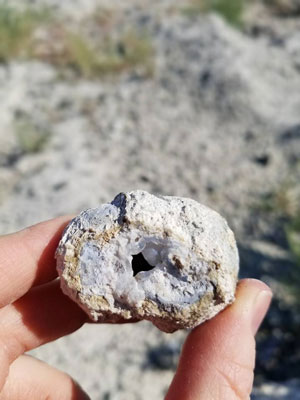This article may include affiliate links. If you click a link and make a purchase, Utah Outdoor Activities may receive a small commission at no extra cost to you. We only recommend products or services we personally use. FTC Affiliate Disclosure.

Geologic information:
Approximately 6 to 8 million years ago (Miocene epoch), volcanic activity occurred in western Utah and deposited an extrusive igneous rock called rhyolite. Trapped gasses formed cavities within the rhyolite, and millions of years of ground-water circulation allowed minerals to precipitate into the cavities. The result is geodes with spherical shapes and crystal-lined cavities.
Roughly 32,000 to 14,000 thousand years ago, a large body of water known as Lake Bonneville covered most of western Utah. The lake's wave activity eroded the geode-bearing rhyolite and redeposited the geodes several miles away in the Dugway geode bed area as lake sediments. Most geodes are typically hollow whereas others are completely filled with massive, banded quartz. The most common mineral found within the geodes is quartz in various colors: clear (rock crystal), purple (amethyst), and pink (rose).
How to get there:
From Salt Lake City take I-80 westbound until you reach the Tooele turnoff (exit 99). Travel south on Highway 36 for about 40.5 miles to the Pony Express Road (which is the dirt road just past Faust). Turn west (right) and proceed 50.1 miles on the Pony Express Road to the Dugway geode bed turnoff. Turn north (right), proceed up the dirt road and look for recent diggings.
Where to collect:

Geodes can be found approximately 1 to 2 miles north/northeast of the turnoff. The easiest technique is to find an area of past excavations and start digging to locate the proper horizon where the geodes can be found. You will be digging in a soft, unconsolidated material that is susceptible to caving, so please be careful! Examine all stones that are encountered. The geodes are fairly easy to recognize due to their spherical shape and light weight. Most geodes are 2 to 3 inches in diameter and are typically lined with small quartz crystals that give the cavity a sugary appearance. I collected fragments and whole geodes near UTM map coordinates 12S 0317569 4416919.
Useful Maps:
Fish Springs 1:100,000- scale topographic map, Dugway Pass 1:24,000-scale topographic map, and a Utah highway map. These maps may be obtained from the Natural Resources Map & Bookstore, 1594 W. North Temple, Salt Lake City, UT 84116, (801) 537-3320 (or 1-888- UTAH-MAP).
Land Ownership:
Bureau of Land Management (BLM) public lands. Active mining claims exist on some portions of the "geode area" so seek permission from the claim owners before collecting. For more information on BLM public lands under claim contact the House Range/Warm Springs BLM field office at (435) 743-3100.
BLM Collecting Rules:
The casual collector may take small amounts of gemstones and rocks from unrestricted federal lands in Utah without obtaining a special permit if collection is for personal, noncommercial purposes. Collection in large quantities or for commercial purposes requires a permit, lease, or license from the BLM.
Miscellaneous: Tools Recommended:
A shovel, pick, safety glasses and hammer (in case you want to break your geodes on the spot). Whole geodes can be taken to your local rock shop to be cut in half. Bring plenty of water and remember to bring a spare tire in case of an unforeseen accident. More importantly, be patient and have fun collecting!
Related Articles:
Campout at the Dugway Geode Beds
Exploring the Dugway Geode Beds
We hope you enjoyed this information. For more outdoor activities, please connect with us on YouTube, Facebook and Instagram. Help us keep this site up and running by visiting our online store which features outdoor themed gifts, decor and more. Thank you for visiting and for your ongoing support!